Since their discovery in the 1960s, laser technology has continuously evolved and has become an integral part of the industry. Lasers are divided into five main types depending upon their gain medium. You can learn about these laser types, their working procedure, and diverse real-world applications in this guide.
What is a Laser?
Laser stands for Light Amplification by Stimulated Emission of Radiation. Laser amplifies the intensity of light and produces highly directional beams powerful enough to cut through the metal surfaces. Furthermore, these light beams can travel miles into the sky.

A laser beam is different from a light beam, which is coherent, collimated & monochromatic. To better understand the functioning of a laser, we need to know its components. Laser has the following main elements:
- Energy Source: It pumps the light into a gain medium, also known as a pumping source. Energy source varies depending upon the type of laser, and it could be a flash lamp, another laser, a chemical reaction, or an electrical discharge.A pumping source is responsible for achieving population inversion since it pumps the molecules or atoms from lower to higher energy.
- Gain Medium: This is the main component of the laser where the laser action occurs. It’s also known as Active Medium or LASER medium. The gain medium determines the wavelength of any laser radiation. The LASER medium may contain gases, liquid dyes, solid crystals & semiconductors.
- Resonator: The resonator uses the mirrors to boost the optical gain of the gain medium. Two types of mirrors are used, including a partially reflective mirror and a highly reflective one.

After discussing lasers in detail, we’re about to look into different types of it.
I. Fiber Laser
Fiber lasers were first introduced in the 1960s, but their commercial use started in the 1990s. Since then, fiber laser technology has evolved, and their efficiency and applications are increasing.
Definition & Basic Structure
Fiber lasers are a category of solid-state lasers that use optical fibers as their active gain medium. These lasers use a phosphate glass or silicate fiber that absorbs raw light from the pumping source. Afterward, this light is transformed into a laser beam of a specific wavelength.
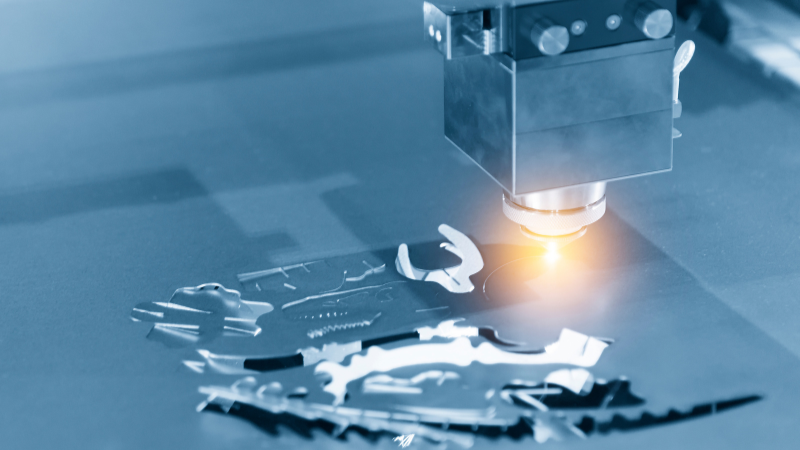
How Does Fiber Laser Work?
Firstly, an energy source is used for the creation of pump light. In fiber lasers, mostly electricity is used as an energy source, which is then converted into light energy using pump laser diodes. Then, a coupler combines the light from multiple resources and converts it into a single source. After collecting the light into an individual laser diode, it is transferred to the gain medium.
During the next stage, the pump light passes through the optical fiber, which consists of the core (light-carrying portion) and cladding (the material surrounding the core). Finally, light reaches the doped fiber part, known as the laser cavity.
In the laser cavity, rare earth elements are used to excite the electrons to a higher energy level. This is done until population inversion is achieved. It is a stage when more electrons are in an excited state than normal. Here, electrons are excited and re-excited until a steady flow of raw laser light is achieved. This light is refined further for use in different applications.
Fiber lasers are energy-efficient, incredibly stable & easy to maintain. These are highly accurate, even in complex designs. However, fiber laser cutting requires proper safety protocols, and its applications are limited to non-metallic materials.
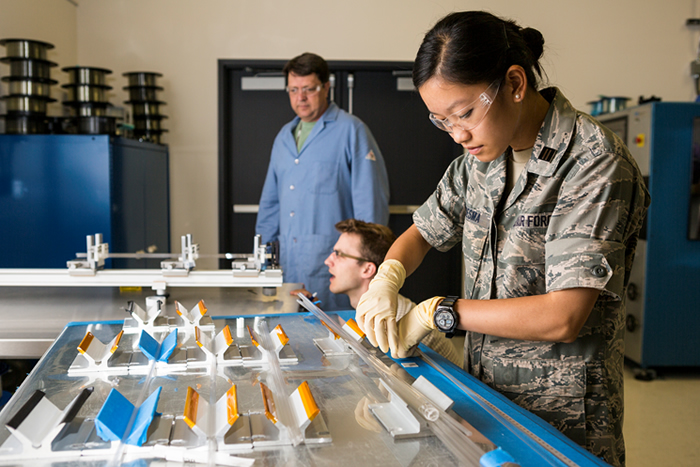
Image source: lasers.llnl.gov
Examples
- Erbium-dopped fiber lasers
- Thulium-dopped fiber lasers
- Ytterbium-dopped fiber lasers
Applications
Fiber lasers produce a wide variety of wavelengths, so they have multiple applications. These can effectively clean the metals; this process is known as metal cleaning and could be customized for different production line parameters.
Furthermore, these have Laser marking applications and help permanently mark plastic and metals with high-contrast markers. Other than marking, fiber lasers are used for engraving, etching, and annealing.
What’s more? Fiber lasers can tackle even complex cuts with impressive edge quality; hence, they are the best option for laser cutting. These have eliminated tooling charges and reduced set-up & downtimes. Besides, fiber lasers provide high precision, safety, and accuracy in diagnostic imaging and surgery.

II. Solid-state Laser
The first solid-state laser was the ruby laser, which was less effective due to its pronounced three-level nature. Afterward, other solid-state media gained popularity due to their better performance.
As their name indicates, the solid-state laser uses a solid medium – a crystalline material or a glass. The solid medium is mixed with rare earth elements like erbium, ytterbium, chromium, or neodymium.
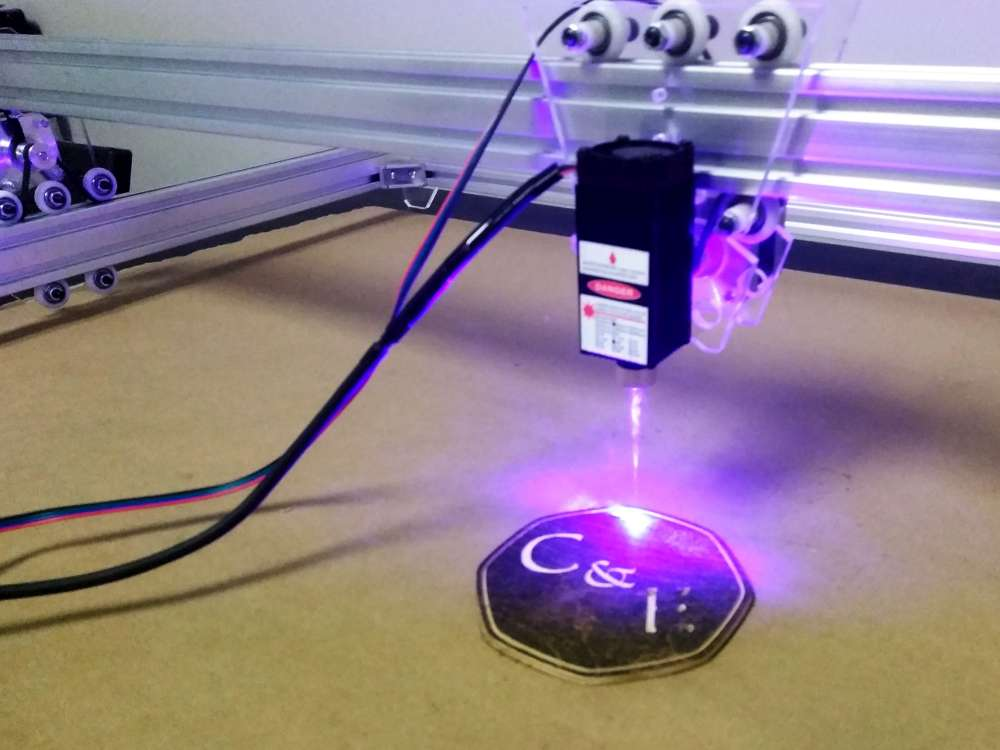
How Does Solid-State Laser Work?
In solid-state lasers, ions are introduced as impurities to host material. This process is called doping, which means adding foreign bodies to a particular substance. The host material used in solid-state laser could be neodymium-dopped yttrium aluminum garnet, neodymium-dopped glass, and sapphire or ytterbium-dopped glass. The dopants include rare earth materials like chromium or erbium.
Besides, arc or flash lamps are used in solid-state lasers for optical pumping. These pump sources are cheap but have a moderate lifetime and low power efficiency. However, a laser diode is used for diode-pumped solid-state (DPSS) lasers. These have the ability to reach high powers along with maintaining a good beam quality.
Solid-state lasers are simple, economical, & have high efficiency. These have comparatively simpler construction than other types & tiny amount of material is lost in the gain medium. The output of solid-state lasers could be both pulsed and continuous. Yet, the efficiency of solid-state lasers is comparatively lower than carbon dioxide lasers.
Examples
Common examples of solid-state lasers include:
- Ti: Sapphire lasers
- Nd: Glass laser(Neodymium glass)
- YB: YAG laser(Ytterbium-Dopped Yttrium Aluminium Garnet)
- Nd: YAG laser(Neodymium-Dopped Yttrium Aluminium Garnet)
Applications
Solid-state material lasers help to drill holes in the metals. These offer flexibility in multiple hole-forming operations and are more effective than traditional methods.
Furthermore, laser drilling is economical and has high accuracy and fast speed. These lasers are used in the military to target the destination system. Also, these lasers are used in calibrated physical instruments like seismographs.
Furthermore, solid-state lasers help to remove tissue ablation, tattoos, hair, and kidney stones. These are used in RGB (red-green-blue) light sources in laser projectors and printers. Besides, solid-state lasers have the potential to be used in nuclear fusion.
III. Gas Laser
Gas laser is different than the other types of lasers as it works on the principle of converting electrical energy into light energy. Also, gas lasers are of different types. The type of gas used to develop the laser medium decides the efficiency and wavelength of the laser.
Definition & Basic Structure
Gas is used as active media in gas lasers. Common gases used for this purpose include carbon dioxide, xenon, hydrogen, fluorine, krypton, argon, neon, and helium.
Gas media can be pumped more efficiently than solid media, so gas lasers have better beam quality and generate high power densities. Common types of gas lasers are helium-neon lasers, carbon dioxide lasers, and argon-ion lasers.
How Does Gas Laser Work?
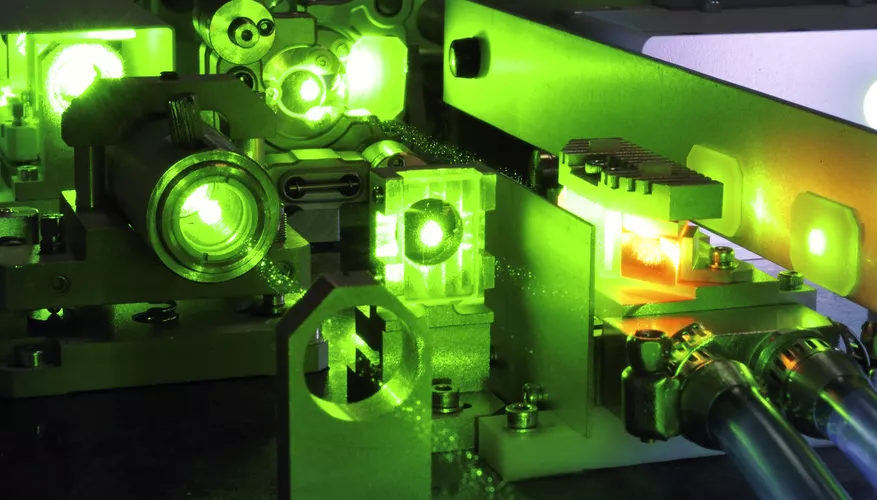
Image Source: sciencing.com
Firstly, gas items are excited through an electrical discharge and boosted towards a higher energy state. The excited atoms are degraded into a lower energy state by emitting photons. When these photons meet an excited atom, these energize the atoms to emit more photons of the same phase, direction, and energy.
These photons are moved back and forth among the mirrors, forming a resonant cavity. During this process, light is amplified, ultimately producing laser beams. Gas lasers produce a high-quality beam, have excellent spatial coherence, and offer a wide range of output wavelengths.
However, gas lasers need high voltage DC power supply, and harmful chemicals are emitted from the gases, which may cause skin and eye injuries in the employees.
Examples
- Excimer lasers
- Krypton lasers
- Argon lasers
- Helium-neon lasers
- Carbon dioxide lasers
Applications
Gas lasers serve multiple purposes in fields ranging from scientific research to medicine and telecommunication. These have excellent beam quality and are used in fiber-optic communication. HeNe lasers are used in educational and lab demonstrations due to their visible red beam and relative safety.
Furthermore, these are used in experiments like particle acceleration, holography, pollution measurements, and spectroscopy. Gas lasers are used in various skin treatments and eye surgery. CO2 gas lasers come in handy in multiple tasks of metal processing like cutting, engraving, and welding. Due to their high absorption in water, CO2 lasers are used for removing tumors, moles, and warts.

IV. Dye Laser
Dye lasers can generate lasers of any frequency of near-ultraviolet, visible, and infrared regions; hence, they are known as tunable lasers. These have a wide variety of applications in various fields.
Definition & Basic Structure
Dye lasers, also known as liquid lasers, use an organic dye as their gain medium. One of their key features is that their wavelength can be controlled during the operation. The commonly used dyes in liquid lasers are sodium fluorescein, rhodamine 6G, or rhodamine B.
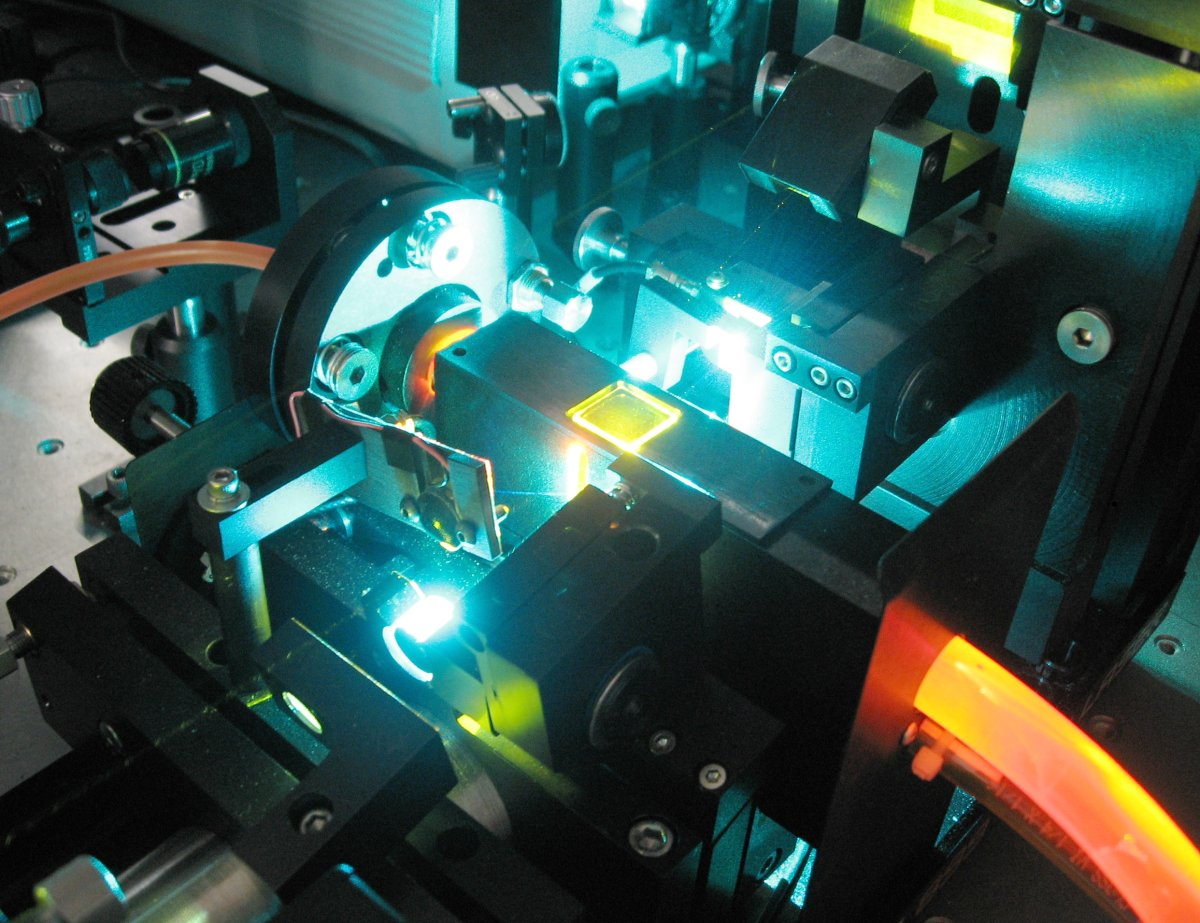
How Does Dye Laser Work?
As we mentioned above, the active medium of liquid laser is an organic dye. At the same time, the solvents used in them could be ethylene glycol, alcohol, or water. Firstly, the dye is pumped into the capillary tube from the storage tank. Dye leaves the tube with a flash bulb, and the output beam is moved to the output coupler with the help of a Brewster window.
The output coupler is a 50% reflective mirror while the output wavelength varies greatly, and the maximum output of 618 nm can be achieved. Dye lasers are available in visible form, have high output power, less beam diameter & divergence.
The variable ranges of wavelengths can be produced through dye lasers and are used for a wide range of functions in the medical field. Yet, dye lasers have a high cost & a highly complex chemical formula.
Examples
- Jet Dye Laser
- Liquid Nitrogen Laser
- Rhodamine 6G Dye Laser
- Dye-Dopped Polymer Laser
- Aromatic Hydrocarbon Dye Laser
Applications
Dye laser treatment treats body scars, including birthmarks like port wine stains, spider veins on the face, etc. Long pulsed dye laser helps to treat blushing and fine lines. Tunable lasers are used in isotope separation. Furthermore, organic dye laser is used in biomedical sciences, holography, and spectroscopy.
These lasers have the potential to excite specific molecules, so they help in molecular sciences to study the characteristics of molecules. Along with solid-state lasers in non-linear crystals, dye lasers produce shorter wavelengths of light like UV. Besides, these are used in photochemistry, where a specific wavelength is needed to start or catalyze a reaction.
V. Semiconductor (Diode) Laser
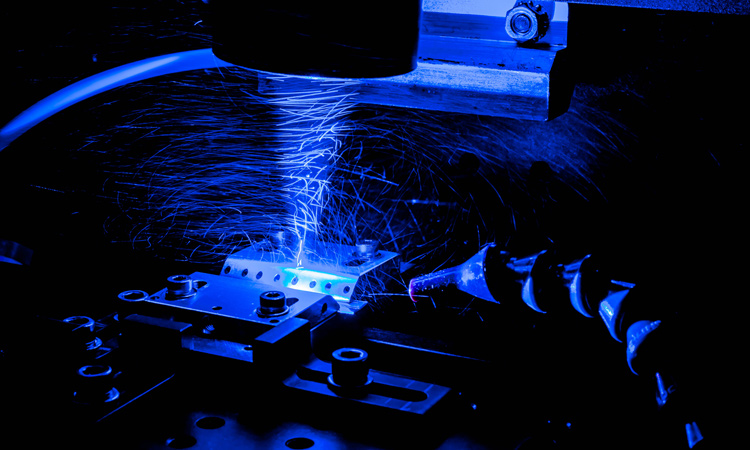
Semiconductor lasers are cost-effective, more efficient, and use less power than other laser systems. These lasers have unique features like monochromatic nature, small light spot size & high light density. Due to these properties, diode lasers are becoming popular in the energy and medical sectors.
Definition & Basic Structure
Laser diodes also have positively-negatively charged junctions (PN) like regular diodes. However, the intrinsic layer of the laser diode is polished to create the spontaneous emission. Since the intrinsic layer is polished, generated photons are amplified, converting the electric current into laser light.
Semiconductor lasers serve critical medical purposes, as these are used in dental procedures, dermatology, and eye surgery. Besides, these are heavily utilized in laser scanners, printers, barcode readers, etc.
How Does Semiconductor (Diode) Laser Work?
The active medium of the semiconductor laser is the forward-biased PN junction diode. In this junction, an n-type semiconductor has excess electrons, while a p-type semiconductor has excess holes. A forward bias voltage is applied, pushing electrons and holes into the junction where they attract and collide. During this process, recombination radiations are produced.
The surplus energy is released as photons, which further stimulate the electron-hole recombination, ultimately producing laser light.
These lasers have a longer lifespan, low maintenance cost, and comparatively safe operation. Also, these use low power and operate on low voltage constant current mode. On the downside, semiconductor lasers are sensitive to temperature variations, and their output laser beam is not narrow.
Examples
- Quantum Cascade Laser
- Edge-Emitting Laser Diode
- External Cavity Diode Laser (ECDL)
Applications
Semiconductor lasers are used in CD and DVD players for reading and writing data. Besides, these help in forensic and biomedical diagnostics. Semiconductor lasers are used in barcode scanners and laser printers. Also, these come in handy in various types of spectroscopy for material characterization and chemical analysis.
Diodes are important light sources for optical fiber communication. High-power diodes help in laser cutting and welding. In medicine, these are used for treating certain skin conditions, teeth whitening, and soft tissue surgeries. Furthermore, diode lasers act as a pumping source for specific types like solid-state lasers.

Comparison of 5 Different Types of Laser
Each laser type has different output power, wavelength, uses, and other traits. We thought of compiling this information in the form of a table for you.
| Laser Type | Example | Output Power | Pulsed or CW | Wavelength | Applications |
|---|
How to Choose the Right Laser for Your Project?
Selecting the appropriate laser for your project involves considering several factors:
- Application Requirements: Identify the specific tasks you need the laser to perform, such as cutting, welding, engraving, or medical applications. Different laser types (CO2, fiber, diode, etc.) are suited to different tasks.
- Material Compatibility: Ensure the laser is compatible with the materials you plan to work with, whether they are metals, plastics, wood, or other substances. Some lasers are more effective on certain materials than others.
- Power and Precision: Determine the power level and precision required for your project. Higher power lasers are suitable for cutting thicker materials, while lower power lasers are better for detailed, delicate work.
- Budget and Maintenance: Consider your budget, including initial costs and long-term maintenance expenses. Some lasers might have higher upfront costs but lower maintenance needs, while others could be cheaper initially but require more upkeep.
By evaluating these factors, you can select the laser that best meets your project’s needs and ensures optimal performance.
FAQs
1. Which laser is used for laser cutting?
CO2 and fiber lasers are used for laser cutting due to their high power and efficiency. CO2 lasers excel in cutting non-metallic materials like wood and plastic, while fiber lasers are ideal for cutting metals with precision.
2. Which laser is used for laser welding?
Fiber lasers are preferred for laser welding because they provide a concentrated heat source and precise control, which ensures strong and clean welds, especially in metals.
3. Which laser is used for laser engraving?
Diode and CO2 lasers are used for laser engraving because they offer fine control for detailed work. CO2 lasers are versatile for various materials, while diode lasers are efficient for marking and engraving on metals and plastics.
Conclusion
Laser technology continuously evolves, and more types are being introduced, opening new opportunities. As the laser technology will improve further, we will see new advancements in the field of science and medicine.
Each laser type has its distinctive benefits, drawbacks, and applications. Whether you are a student who wants to learn about various types of laser or a businessman looking forward to harnessing the power of laser technology, this guide will help!
Investing in Laser System? Get Free Sample Proofing at Baison!
Laser technology is vast, making it difficult to decide the most suitable option for you. There is no one-size solution that fits all, so don’t settle for less. Let Baison do the guesswork and help you choose the RIGHT laser system that meets your distinctive needs. We offer comprehensive evaluations in laser marking, cleaning, laser cutting, and welding in one place.





